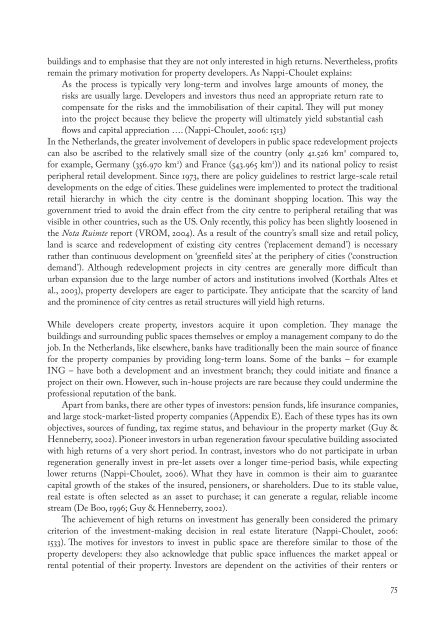Changing public space
Changing public space
Changing public space
You also want an ePaper? Increase the reach of your titles
YUMPU automatically turns print PDFs into web optimized ePapers that Google loves.
uildings and to emphasise that they are not only interested in high returns. Nevertheless, profits<br />
remain the primary motivation for property developers. As Nappi-Choulet explains:<br />
As the process is typically very long-term and involves large amounts of money, the<br />
risks are usually large. Developers and investors thus need an appropriate return rate to<br />
compensate for the risks and the immobilisation of their capital. They will put money<br />
into the project because they believe the property will ultimately yield substantial cash<br />
flows and capital appreciation …. (Nappi-Choulet, 2006: 1513)<br />
In the Netherlands, the greater involvement of developers in <strong>public</strong> <strong>space</strong> redevelopment projects<br />
can also be ascribed to the relatively small size of the country (only 41.526 km 2 compared to,<br />
for example, Germany (356.970 km 2 ) and France (543.965 km 2 )) and its national policy to resist<br />
peripheral retail development. Since 1973, there are policy guidelines to restrict large-scale retail<br />
developments on the edge of cities. These guidelines were implemented to protect the traditional<br />
retail hierarchy in which the city centre is the dominant shopping location. This way the<br />
government tried to avoid the drain effect from the city centre to peripheral retailing that was<br />
visible in other countries, such as the US. Only recently, this policy has been slightly loosened in<br />
the Nota Ruimte report (VROM, 2004). As a result of the country’s small size and retail policy,<br />
land is scarce and redevelopment of existing city centres (‘replacement demand’) is necessary<br />
rather than continuous development on ‘greenfield sites’ at the periphery of cities (‘construction<br />
demand’). Although redevelopment projects in city centres are generally more difficult than<br />
urban expansion due to the large number of actors and institutions involved (Korthals Altes et<br />
al., 2003), property developers are eager to participate. They anticipate that the scarcity of land<br />
and the prominence of city centres as retail structures will yield high returns.<br />
While developers create property, investors acquire it upon completion. They manage the<br />
buildings and surrounding <strong>public</strong> <strong>space</strong>s themselves or employ a management company to do the<br />
job. In the Netherlands, like elsewhere, banks have traditionally been the main source of finance<br />
for the property companies by providing long-term loans. Some of the banks – for example<br />
ING – have both a development and an investment branch; they could initiate and finance a<br />
project on their own. However, such in-house projects are rare because they could undermine the<br />
professional reputation of the bank.<br />
Apart from banks, there are other types of investors: pension funds, life insurance companies,<br />
and large stock-market-listed property companies (Appendix E). Each of these types has its own<br />
objectives, sources of funding, tax regime status, and behaviour in the property market (Guy &<br />
Henneberry, 2002). Pioneer investors in urban regeneration favour speculative building associated<br />
with high returns of a very short period. In contrast, investors who do not participate in urban<br />
regeneration generally invest in pre-let assets over a longer time-period basis, while expecting<br />
lower returns (Nappi-Choulet, 2006). What they have in common is their aim to guarantee<br />
capital growth of the stakes of the insured, pensioners, or shareholders. Due to its stable value,<br />
real estate is often selected as an asset to purchase; it can generate a regular, reliable income<br />
stream (De Boo, 1996; Guy & Henneberry, 2002).<br />
The achievement of high returns on investment has generally been considered the primary<br />
criterion of the investment-making decision in real estate literature (Nappi-Choulet, 2006:<br />
1533). The motives for investors to invest in <strong>public</strong> <strong>space</strong> are therefore similar to those of the<br />
property developers: they also acknowledge that <strong>public</strong> <strong>space</strong> influences the market appeal or<br />
rental potential of their property. Investors are dependent on the activities of their renters or<br />
75




